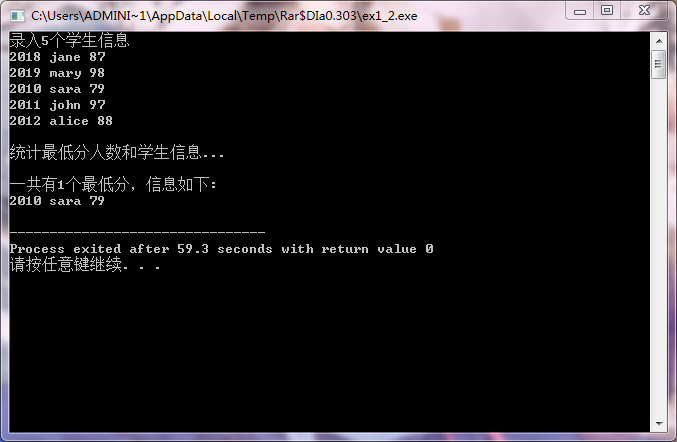第六次实验
Part 1
1.1.2
#include <stdio.h> const int N=5; // 定义结构体类型struct student,并定义STU为其别名 typedef struct student { long no; char name[20]; int score; }STU; // 函数声明 void input(STU s[], int n); int findMinlist(STU s[], STU t[], int n); void output(STU s[], int n); int main() { STU stu[N], minlist[N]; int count; printf("录入%d个学生信息\n", N); input(stu, N); printf("\n统计最低分人数和学生信息...\n"); count = findMinlist(stu, minlist, N); printf("\n一共有%d个最低分,信息如下:\n", count); output(minlist, count); return 0; } // 输入n个学生信息,存放在结构体数组s中 void input(STU s[], int n) { int i; for(i=0; i<n; i++) scanf("%ld %s %d", &s[i].no, s[i].name, &s[i].score); } // 输出结构体s中n个元素信息 void output(STU s[], int n) { int i; for(i=0; i<n; i++) printf("%ld %s %d\n", s[i].no, s[i].name, s[i].score); } // 在结构体数组s中,查找最低分学生的记录,将其存入结构体数组s中 // 形参n是结构体数组s中元素个数 // 函数返回最低分的学生人数 int findMinlist(STU s[], STU t[], int n) { // 补足函数实现 int i,j=0; int min; min=s[0].score; for(i=0;i<n;i++){ if(s[i].score<min){ min=s[i].score; } } for(i=0;i<n;i++){ if(min==s[i].score){ t[j++]=s[i]; } } return j; }

1.3
#include <stdio.h> #include <string.h> const int N = 10; // 定义结构体类型struct student,并定义其别名为STU typedef struct student { long int id; char name[20]; float objective; /*客观题得分*/ float subjective; /*操作题得分*/ float sum; char level[10]; }STU; // 函数声明 void input(STU s[], int n); void output(STU s[], int n); void process(STU s[], int n); int main() { STU stu[N]; printf("录入%d个考生信息: 准考证号,姓名,客观题得分(<=40),操作题得分(<=60)\n", N); input(stu, N); printf("\n对考生信息进行处理: 计算总分,确定等级\n"); process(stu, N); printf("\n打印考生完整信息: 准考证号,姓名,客观题得分,操作题得分,总分,等级\n"); output(stu, N); return 0; } // 录入考生信息:准考证号,姓名,客观题得分,操作题得分 void input(STU s[], int n) { // 补足代码 // ××× int i; for(i=0;i<n;i++){ scanf("%ld %s %f %f",&s[i].id,s[i].name,&s[i].objective,&s[i].subjective); } } //输出考生完整信息: 准考证号,姓名,客观题得分,操作题得分,总分,等级 void output(STU s[], int n) { // 补足代码 // ××× int i; for(i=0;i<n;i++){ printf("%ld %s %f %f %f %s\n",s[i].id,s[i].name,s[i].objective,s[i].subjective,s[i].sum,s[i].level); } } // 对考生信息进行处理:计算总分,排序,确定等级 void process(STU s[], int n) { // 补足代码 // ××× int i,j; STU t; //计算总分 for(i=0;i<n;i++){ s[i].sum=s[i].objective+s[i].subjective; } //冒泡法排序 for(i=0;i<n-1;i++){ for(j=0;j<n-1-i;j++){ if(s[j].sum<s[j+1].sum){ t=s[j]; s[j]=s[j+1]; s[j+1]=t; } } } //确定等级 strcpy(s[0].level,"优秀"); for(i=1;i<=4;i++){ strcpy(s[i].level,"合格"); } for(i=5;i<=9;i++){ strcpy(s[i].level,"不合格"); } }

Part 2
共用体与结构体类型的区别
共用体:几个不同类型的变量共占一段内存。
结构体:内部数据成员在内存中连续存放,每个成员分别占有独立的存储空间。
Part 3
枚举类型适用于变量取值有限的情形。
使用注意事项:
1.枚举类型不能直接输入输出。
2.枚举类型可以隐含转换为整形,但整形转换为枚举类型必须显式转换。






